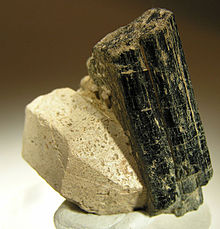Hornblende
| Hornblende | |
|---|---|
 Hornblende crystal (dark green) about 35 mm long, with apatite (white) | |
| General | |
| Category | Silicate mineral |
| Formula (repeating unit) | Ca2(Mg,Fe,Al)5(Al,Si)8O22(OH)2 |
| IMA symbol | Hbl[1] |
| Crystal system | Monoclinic |
| Space group | C2/m |
| Identification | |
| Color | Black to dark green or brown |
| Crystal habit | Hexagonal/granular |
| Cleavage | Imperfect at 56° and 124° |
| Fracture | Uneven |
| Mohs scale hardness | 5–6 |
| Luster | Vitreous to dull |
| Streak | Pale gray, gray-white,[2][3] white, colorless[4] |
| Specific gravity | 2.9 |
| Pleochroism | Strong |
| References | [5] |
Hornblende is a complex inosilicate series of minerals (ferrohornblende – magnesiohornblende).[6] It is not a recognized mineral in its own right, but the name is used as a general or field term, to refer to a dark amphibole. Hornblende minerals are common in igneous and metamorphic rocks.
The general formula is (Ca,Na)2-3(Mg,Fe,Al)5(Al,Si)8O22(OH,F)2.
Compositional variances[]
Some metals vary in their occurrence and magnitude:[7]
- Manganese and titanium are often present.
- Sodium and potassium are often present and fluorine often substitutes for the hydroxyl in the crystalline structure.
Physical properties[]
Hornblende has a hardness of 5–6, a specific gravity of 2.9–3.4 and is typically an opaque green, greenish-brown, brown or black color.
Its planes of cleavage intersect at 56° and 124° angles. Hornblende is most often confused with the pyroxene series and biotite mica, which are also dark minerals found in granite and charnockite. Pyroxenes differ in their cleavage planes, which intersect at 87° and 93°.[8]
Occurrence[]
Hornblende is a common constituent of many igneous and metamorphic rocks such as granite, syenite, diorite, gabbro, basalt, andesite, gneiss, and schist.
It is the principal mineral of amphibolites. Very dark brown to black hornblendes that contain titanium are ordinarily called basaltic hornblende, from the fact that they are usually a constituent of basalt and related rocks. Hornblende alters easily to chlorite and epidote.
A rare variety of hornblende contains less than 5% of iron oxide, is gray to white in color, and is named edenite from its locality in Edenville, Orange County, New York.
Other minerals in the hornblende series include:
Etymology[]
The word hornblende is derived from German Horn ('horn') and blende ('deceive'), in allusion to its similar appearance to metal-bearing ore minerals.[7]
See also[]
- List of minerals – List of minerals for which there are articles on Wikipedia
References[]
- ^ Warr, L.N. (2021). "IMA–CNMNC approved mineral symbols". Mineralogical Magazine. 85 (3): 291–320. Bibcode:2021MinM...85..291W. doi:10.1180/mgm.2021.43. S2CID 235729616.
- ^ http://www.mindat.org/min-1519.html Mindat Ferrohornblende
- ^ http://www.mindat.org/min-2524.html Mindat Magnesiohornblende
- ^ "Hornblende Mineral | Uses and Properties".
- ^ Phillips, M.W.; Draheim, J.E.; Popp, R.K.; Clowe, C.A.; Pinkerton, A.A. (1989). "Effects of oxidation-dehydrogenation in tschermakitic hornblende". American Mineralogist. 74: 764–773. Retrieved 30 December 2020.
- ^ http://www.mindat.org/min-8789.html Mindat
- ^ a b Handbook of Mineralogy
- ^ Pough, Frederick H. (1976). A Field Guide To Rocks and Minerals (4 ed.). Boston: Houghton Mifflin. p. 249.
Additional reading[]
- Hurlbut, Cornelius S.; Klein, Cornelis, 1985, Manual of Mineralogy, 20th ed., John Wiley and Sons, New York, pp. 416–17, ISBN 0-471-80580-7
- Inosilicates
- Calcium minerals
- Iron minerals
- Magnesium minerals
- Aluminium minerals
- Monoclinic minerals
- Minerals in space group 12